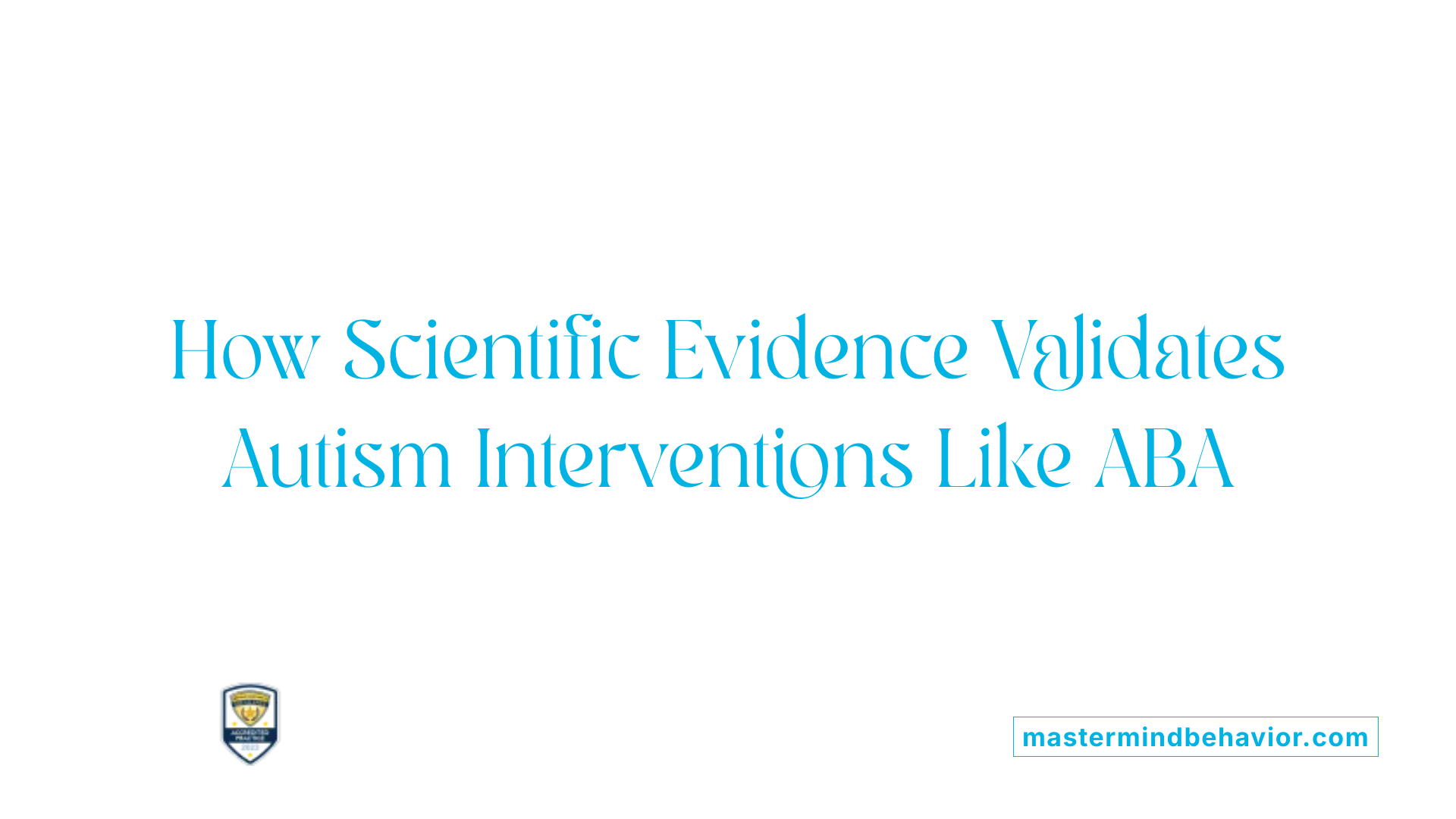The Science Behind Evidence-Based Autism Interventions

Understanding the Role of Scientific Validation in Autism Interventions
Autism spectrum disorder (ASD) presents a complex array of symptoms and challenges, necessitating interventions grounded in robust scientific research. Over the past few decades, the field has increasingly emphasized evidence-based practices (EBPs) to ensure safety, efficacy, and meaningful outcomes. This article explores the scientific principles behind these interventions, their validation processes, and the critical role of rigorous research methodologies in establishing effective treatments for individuals with autism.
The Evolution and Significance of Evidence-Based Practices in Autism

Why is scientific validation important in selecting autism interventions?
Scientific validation plays a vital role in choosing effective treatments for autism spectrum disorder (ASD). It ensures that interventions are backed by rigorous research, demonstrating their safety and effectiveness through systematic testing. Validated practices have undergone multiple studies that confirm their reliability and generalizability, which helps protect against pseudoscience and unproven therapies.
High-quality research methods, such as randomized controlled trials (RCTs) and systematic reviews, are central to establishing this validity. These studies analyze whether interventions produce meaningful improvements in social, communicative, and behavioral skills. Moreover, scientific validation involves understanding biological mechanisms and using biomarkers to tailor personalized treatments, meeting individual needs more precisely.
Overall, scientific validation offers confidence to clinicians, parents, and policymakers, ensuring that resources are directed toward treatments with proven benefits. This foundation helps prevent ineffective or harmful practices from being adopted widely, fostering a science-based approach to autism treatment.
What research methodologies are used to establish evidence-based practices for autism?
The development of evidence-based practices (EBPs) relies heavily on rigorous research methodologies. The most prominent among these are randomized controlled trials (RCTs), which are considered the gold standard for testing intervention efficacy. RCTs involve randomly assigning participants to different treatment groups to compare outcomes objectively.
In addition to RCTs, single case experimental designs are extensively used, especially in behavioral research. These involve detailed observation of individual participants over time to assess the direct effects of an intervention. Systematic reviews aggregate findings from multiple studies, synthesizing evidence to evaluate overall effectiveness.
These methodologies emphasize replication, control for confounding variables, and require transparent reporting to ensure scientific rigor. By applying these standards, researchers can confidently identify which practices genuinely improve outcomes and are suitable for widespread implementation.
How are specific autism interventions like applied behavior analysis (ABA) validated by scientific evidence?
Applied behavior analysis (ABA) has a substantial body of scientific evidence supporting its use. This validation comes from thousands of controlled studies, including RCTs and single case designs, demonstrating ABA's effectiveness in improving a range of skills in children and adults with ASD.
Meta-analyses pooling data from multiple studies reveal consistent positive outcomes, such as enhanced communication, social skills, and adaptive behaviors. For example, systematic reviews often cite dozens of studies showing significant gains in language development and reduction in maladaptive behaviors following ABA therapy.
Despite the positive evidence, ongoing research explores refining ABA methods and understanding their impact on core ASD symptoms. The extensive history of validated research affirms ABA as an evidence-based approach, guiding its widespread adoption in clinical settings worldwide.
Bridging Science and Practice in Autism Interventions
The scientific validation of autism interventions hinges on rigorous research, methodological soundness, and continuous evaluation. As our understanding of ASD advances, so does the sophistication of evidence-based treatments, ensuring that individuals receive care rooted in the best available scientific knowledge. Organizations worldwide, including agencies like the CDC, the National Autism Center, and the NPDC, play vital roles in synthesizing and disseminating research findings to promote practices that are safe, effective, and tailored to individual needs. The ongoing challenge remains translating this wealth of scientific evidence into widespread, consistent implementation in community settings, which is essential for maximizing positive outcomes for those on the spectrum. As research techniques evolve, embracing technological innovations and biological markers, the future of autism treatment looks promising—focused on precision, personalization, and the unwavering commitment to scientific integrity.
References
- Evidence-Based Practices for Children, Youth, and Young Adults ...
- The Complexities of Establishing Evidence-Based Interventions for ...
- Autism Treatment with Evidence-Based Practices
- What does it mean for an autism intervention to be evidence-based?
- Overview of Evidence-based Interventions in ASD
- Evidence-based Treatment Options for Autism
- Evidenced-Based Interventions for Children With Autism Spectrum ...
- Considerations in implementing evidence-based early autism ...
Recent articles

How Culture and Diversity Impact ABA Therapy Outcomes
Bridging Cultures to Enhance Therapy Success in Autism Care

Safety Planning for Problem Behaviors in ABA Programs
Comprehensive Strategies to Ensure Safety and Success in ABA Interventions

Finding Support: Financial Aid And Insurance Advocacy For ABA Therapy
Navigating Financial and Insurance Support for ABA Therapy

The Importance Of Reinforcement Diversity In ABA Programs
Enhancing ABA Therapy Through Varied Reinforcement Approaches

How ABA Therapy Encourages Self-Expression Through Communication
Unlocking Voices: The Role of ABA Therapy in Enhancing Communication for Autism

How ABA Therapy Reduces Inflexible Behavior Patterns
Unlocking Flexibility: The Transformative Impact of ABA Therapy on Autism Behaviors



